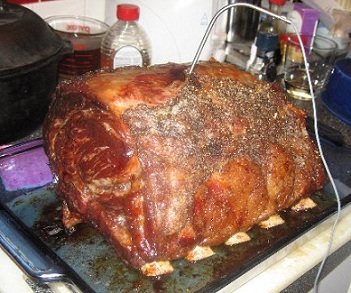What To Tell Your Butcher
Tell your butcher you want a 4, 5, 6 or 7-bone standing rib roast. A 7-bone roast is the whole primal cut. If you need a 2, 3 or 4-bone roast tell the butcher you would prefer it be cut from the loin end, if he would please. A 4-bone rib roast will weigh in at 8-10 lbs. I cooked a 7 bone Prime Standing rib roast for Thanksgiving one year and it was killer. We ate on it for a week. If you would like to age the roast yourself follow this recipe below.
Aged Standing Rib Roast
What You Will Need:
- 10 lbs beef rib roast - 4 bone standing rib
- 3 Tbsp Lemon Pepper - McCormick's brand is by far the best
- 1 Cup Red Wine - good drinkable wine if you don't use it in the sauce, drink it.
- 1/2 tsp kosher salt - or more to taste
- 1/2 tsp black pepper - freshly ground, or more to taste
- 5 leaves Sage - fresh is best 1/2 tsp if dry
- 2 twigs Thyme - fresh or 1/2 tsp dry
Method:
Age The Meat:
- Remove all the wrapping or butcher’s paper from the roast when you get home.

- Place the standing rib roast bone ends down, fat side up on a roasting pan to allow air to circulate and juices to drain off.
- DO NOT allow the meat to sit in any liquid.
- Put the meat, pan and all, into a refrigerator at approximately 50 to 60 percent humidity and between 34 and 38 degrees F.
- You can measure both with a refrigerator thermometer but that is what most refrigerators measure. Flip the meat over daily.
- You want the meat to dry not rot.
- It is not recommended to age with this method for more than 4 days.
- But if that is what you are going to do, don’t bother at all.
- Aging does not have any noticeable effect until about 30 days. I regularly age large cuts of beef for 30 to 45 days without any problem.
- But you use your better judgement. If you are the least bit unsure ask your butcher to do it.
- The point of aging meat is to start the natural breakdown of the muscle fibre. As the muscle breaks down the meat loses liquid and becomes drier and much more tender. The beef flavor is concentrated.
- What you gain in tenderness and flavor you lose in weight and size. Meat I age for 30-45 days loses close to half its original weight after moisture lose and the hard dry pieces are trimmed away after aging.
- Trim off any hard dry parts and large chunks of fat if they exist. Leave at least 1/4 inch of fat, it is where the flavor is.
To Cook The Meat:
- Preheat the oven to 250 degrees Remove the roast from the refrigerator and rub with olive oil.
- Remember to rub the bones with oil, as well.
- Cover the roast with McCormick’s Lemon Pepper, or Kosher salt and ground black pepper.
- Place the roast on your oven rack, set the rack low enough for the height of the roast and cover the roast loosely with aluminum foil.

- Place a pan under the roast to catch the drippings which will be needed for the sauce.
- Place a probe thermometer into the center of the roast and set for 118 degrees.
- Close the oven door and turn the oven down to 220 degrees F and roast until internal temperature of 118 is reached.
- This could take 4 hours or more. Make sure to check the internal temperature.
Rest The Meat
- Remove the roast and turn the oven up to 500 degrees F.
- Allow the foil covered roast to rest until it’s internal temperature reaches 130 degrees on your probe thermometer.
- Yes, it will continue to rise from 118 to 130.
- If for some reason it does not hit that number after 30 minutes, continue to the next step anyhow.
Reverse Sear
- Remove the foil and place the roast back into the preheated 500 degree F oven and sear for about 10-15 minutes or until you have achieved the crust you like.
- The Crusty sear can also be achieved in a cast iron skillet on high with a small amount of olive oil in the bottom.
- Either way turn as needed to crust all over.
Rest The Roast
- Remove and transfer the roast to a cutting board or serving dish to catch any juices.
- Re-cover with foil until ready to serve, resting for at least 20 minutes before slicing.

For the Sauce
- Take the pan that was under the roast while it cooked and degrease the juices in the glass pan by spooning out all but about 2 T of grease.
- Place the pan over low heat on the stove top and deglaze by slowly pouring in 1 cup of water (this could also be wine)

- Stir with a wooden spoon or spatula, scraping to dissolve the crusty bits of droppings from the roast.
- Add 1/2 cup of wine and reduce by half, stirring occasionally.
- Roll the sage and thyme leaves in between your fingers to release the flavors and aroma.
- Add the herbs to the sauce and cook for 1 minute.
- Taste and adjust seasonings.
- strain and serve this sauce on the side in a gravy bowl.
Notes
Nutrition

